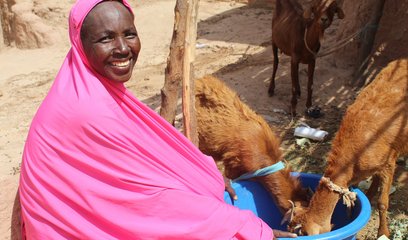-
4.5 million
4.5 million people need humanitarian aid
-
52 %
52% of people live below the poverty line
Niger: Key facts
- Population: 28.2 million
- Area: 1,266,700 KM2
- Literacy rate: 38.1%
- Life expectancy: 62 years
Niger is located in the heart of the Sahel region and is one of the largest countries in Africa. Heat and drought characterise the country, which is largely covered by desert.
"Niger is struggling with climate change, conflict, political instability and hunger," says Yawo Douvon, CARE Country Director for Niger and Burkina Faso.
Niger is one of the poorest countries in the world. In 2024, 4.5 million people, around 17% of the population, were dependent on humanitarian aid. More than half of the population (52 percent) lives below the national poverty line. Around 3.4 million people do not have enough to eat (as of September 2024). Niger also has one of the fastest growing populations in the world.
Fleeing from open conflicts
The Sahel is considered one of the most conflict ridden regions on the continent. An important transit route for migrants to Europe runs through Niger. Violence is particularly frequent in the border regions with Mali, Burkina Faso and Nigeria. The danger to the population is particularly high here.
At the end of September 2024, there were more than 507,000 internally displaced persons. Niger was also home to over 416,000 refugees and asylum seekers, mainly from Nigeria and Mali.
Climate crisis destroys harvests
Floods and droughts destroy people's livelihoods. Around 80 percent of the population live in rural areas and are dependent on agriculture as a source of income. In the 2024 rainy season, flooding washed away the roads. Over a million people were affected and hundreds lost their lives.
Flooding increases the risk of waterborne diseases such as cholera. The start of the school year had to be postponed by several weeks due to the flooding. In addition, thousands of classrooms were damaged, destroyed or had to house displaced families.
CARE in Niger
CARE began working in Niger in 1974 with support during a famine. Today, our work focuses on the areas of health and nutrition, climate justice, education and the empowerment of women and girls.
CARE's has launched a successful "Village Savings and Loan Associations" (VSLA) program in Niger. These are village savings groups through which women receive microloans and can build their own livelihoods.
Together with local partner organisation HED-Tamat, CARE raises awareness of the dangers of radical movements and provides training in conflict resolution techniques. With partner "Action en Faveur des Vulnérables (AFV)", CARE has provided emergency aid for around 23,000 people in the areas of health, nutrition and water supply.
Ten forgotten crises
The CARE Crisis Report is published annually and highlights the ten crises that receive the least media attention. In 2024 Niger ranked as the tenth least reported crisis in the world.
